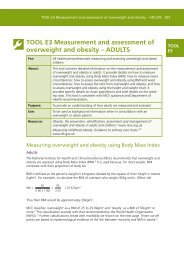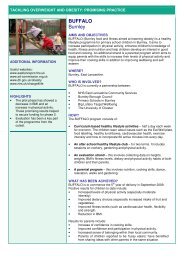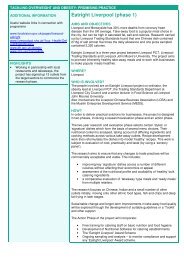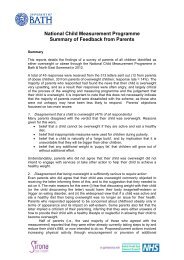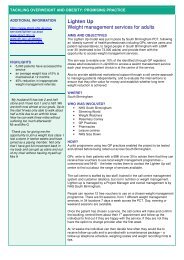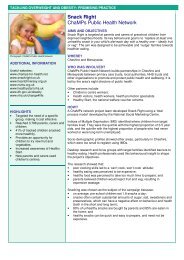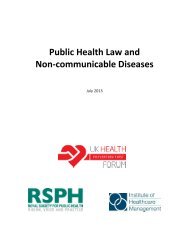The Challenge of Non-Communicable Diseases and Road Traffic ...
The Challenge of Non-Communicable Diseases and Road Traffic ...
The Challenge of Non-Communicable Diseases and Road Traffic ...
You also want an ePaper? Increase the reach of your titles
YUMPU automatically turns print PDFs into web optimized ePapers that Google loves.
An Overview 59<br />
for managing chronic conditions, with the Chronic<br />
Care Model (CCM) [413] <strong>and</strong> WHO’s related Innovative<br />
Care for Chronic Conditions (ICCC)<br />
framework [414](Figure 19) amongst the most wellknown<br />
[415]. <strong>The</strong>re have also been attempts to exp<strong>and</strong><br />
the model to better integrate health promotion<br />
<strong>and</strong> prevention aspects [416].<br />
<strong>The</strong> main models have been applied in a number<br />
<strong>of</strong> countries, the CCM most frequently in high income<br />
countries [417-418] while the ICCC framework<br />
has been applied in a more diverse range <strong>of</strong><br />
settings [419]. While there is evidence that single<br />
or multiple components <strong>of</strong> the Chronic Care Model<br />
(such as self-management support, delivery system<br />
design, decision support, <strong>and</strong> clinical information<br />
systems) improve quality <strong>of</strong> care, clinical outcomes,<br />
<strong>and</strong> the use <strong>of</strong> health care resources, it is less clear if<br />
the whole model is needed, or whether only some<br />
components would be sufficient [420-421].<br />
Chronic care models are already being applied in<br />
the care <strong>of</strong> chronic conditions <strong>of</strong> infectious origin<br />
such as HIV/AIDS <strong>and</strong> adapted for use in Africa<br />
[422-423](Box 11). <strong>The</strong> otherwise limited application<br />
in LMIC, however, may reflect the need for a<br />
level <strong>of</strong> capacity <strong>and</strong> resourcing that is out <strong>of</strong> reach<br />
for many countries at present [215]. Models <strong>of</strong> care<br />
developed in one setting may not easily translate to<br />
another although they may be more easily implemented<br />
in health systems with a strong primary care<br />
orientation [420].<br />
A health care delivery system can be designed,<br />
even for very low-income populations that decen-<br />
FIGURE 19: Innovative Care for Chronic Conditions Framework<br />
POSITIVE POLICY ENVIRONMENT<br />
Strengthen partnerships<br />
Support legislative<br />
frameworks<br />
Integrate policies<br />
Provide leadership & advocacy<br />
LINKS<br />
Promote<br />
consistent financing<br />
Develop & allocate<br />
human resources<br />
COMMUNITY<br />
Raise awareness &<br />
reduce stigma<br />
Encourage better outcomes<br />
through leadership & support<br />
Mobilize & coordinate resources<br />
Provide complementary<br />
services<br />
COMMUNITY SUPPORTERS<br />
Prepared<br />
Informed<br />
Motivated<br />
HEALTH-CARE TEAM<br />
PATIENTS AND FAMILIES<br />
HEALTH CARE<br />
ORGANIZATION<br />
Promote continuity & coordination<br />
Encourage quality through<br />
leadership & incentives<br />
Organize & equip<br />
health-care teams<br />
Use information systems<br />
Support self-management<br />
& prevention<br />
BETTER OUTCOMES FOR CHRONIC CONDITIONS<br />
Source: [414]




